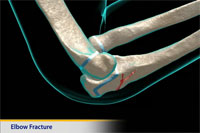
Broken Elbow
What is a broken elbow?
A broken elbow is most often a crack or break in the part of the elbow called the olecranon. The olecranon is the bony tip that you feel directly under the skin of the elbow. It extends from one of the lower arm bones, called the ulna. The olecranon is not protected by muscles or other soft tissues.
How does it occur?
Broken elbows usually occur as the result of an injury either from a fall or from a direct blow to the elbow. Occasionally the injured bones are out of alignment with the other bones of the elbow joint. This is called a dislocation.
Your child's bones are different than those of an adult. First, they are more flexible. Sometimes the bones crack like green branches from a live tree instead of snapping like a dry stick. Other times the bones just buckle slightly. The second major difference is that a child's bones are still growing from areas near the end of the bones called growth plates. Fractures in the growth plate can be difficult to see on the X-ray and they may affect the growth of the bone. Sometimes special tests are needed to diagnose fractures in this area.
What are the symptoms?
Symptoms of a broken elbow include:
- severe pain
- swelling
- difficulty bending or straightening the elbow
- a grating feeling when the elbow is moved caused by the broken bones moving against each other
- muscle spasms
- an obvious deformity of the elbow
How is it diagnosed?
Your child's provider will talk to you about how the elbow was injured, examine the elbow and any other injured areas, and order an X-ray of your child's elbow.
How is it treated?
The treatment for your child's broken elbow will depend on the injury. If the joint is dislocated then it will have to be put back into alignment. If just a small piece of bone is broken at the end of the bone it may be treated with a splint or cast. If a larger part of the bone is broken or if the break is in the joint itself then your child may need surgery to repair the bone. Your child will also be given a sling to support the elbow.
How can I help take care of my child?
To reduce swelling keep the injured elbow elevated on pillows when your child is resting. For the first day or two, put ice packs on the injured elbow. Put the ice pack on for 10 minutes and then leave it off for 20 minutes.
Most cast material is not made to get wet. If your child needs a cast that can get wet talk to your provider. Your child's provider will determine if the fracture may be safely treated with a waterproof cast.
Don't let your child scratch around or poke things down the cast as this may lead to an infection.
How long will the effects last?
Children tend to heal faster than adults but, healing times vary from one child to the next. As a rule most fractures heal in 4 to 6 weeks. Your child's provider may repeat X-rays to check on the pace of healing 2 or 3 weeks after the injury.
Depending on the type of injury and how it was treated your child may need to do rehabilitation exercises. Most of the time pre-teen children are so active that they regain strength and flexibility without physical therapy.
When should I call my child's healthcare provider?
Call immediately or go to the emergency room if:
- Your child has increased pain, redness, warmth, or swelling.
- Your child has a loss of sensation in the hand, arm, or elbow.
- The injured elbow, forearm, or hand looks pale, blue, or feels cold.

